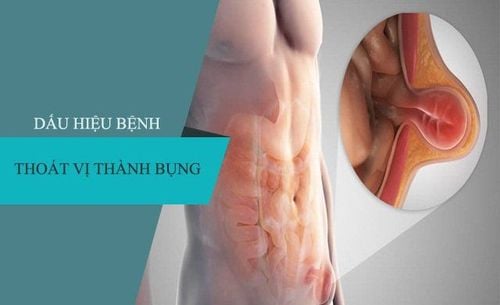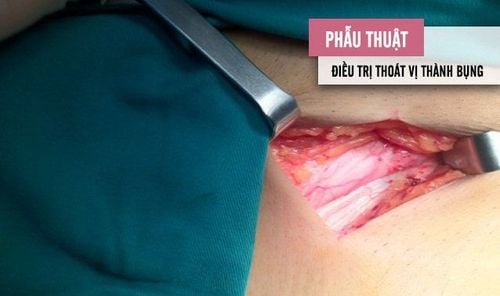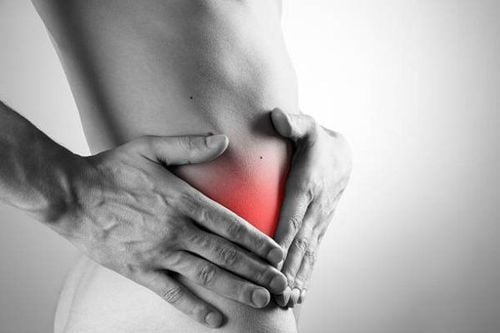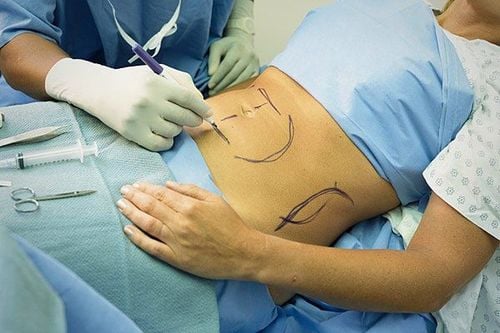This is an automatically translated article.
The article is professionally consulted by Doctor, Dr. Do Minh Hung - Department of General Surgery - Vinmec Central Park International General Hospital33% of patients had surgery on the abdominal wall to treat any disease that is likely to have a hernia of the abdominal wall after surgery and of these patients, 33% of patients will need surgery to treat the abdominal wall hernia. This is because at the incision site, the muscles around the surgical scar are weakened, leading to part of the intestines coming out of the abdominal wall. This phenomenon is common in the elderly, overweight people, people who are less active after surgery, people who have to operate many times through an incision.
1. Symptoms of abdominal wall hernia after surgery
The most noticeable symptom of a hernia after an incision is a bulge near the incision site. The bulge is most often seen when you strain a muscle, such as when you stand up, lift something, or cough. Besides the obvious abdominal bulge, a post-operative hernia can also cause:Nausea and vomiting Fever Burning or pain near the hernia Abdominal pain and discomfort, especially around the site of the hernia Faster-than-normal heartbeat Constipation Diarrhea The highest risk of postoperative abdominal wall herniation usually occurs three to six months after surgery, but hernias can occur before or after the time frame this.
There are two types of abdominal wall hernia after surgery:
Depressible hernia: is a hernia that can disappear when lying down or when pressed. Hernia that cannot be flattened: is when the hernia is stuck or strangled, the herniated organ cannot be pushed into the abdomen. At this time, the patient may have pain or symptoms of intestinal obstruction, the risk of bowel necrosis... The patient needs to be examined soon and may have to have emergency surgery.

Nguy cơ bị thoát vị thành bụng sau mổ cao nhất thường diễn ra vào khoảng từ ba đến sáu tháng
2. Causes of abdominal wall hernia after surgery
Post-incisional abdominal wall hernia occurs when an incision in the abdominal wall causes the tendons and muscles to fail to heal properly leading to weakness or opening of the abdominal muscles, allowing tissues and organs to protrude through the abdominal wall through a weak position or open, creating a bulge in the abdominal wall.Several factors limit wound healing such as:
Increased intra-abdominal pressure Rapid weight gain after surgery Pregnancy before the incision has fully healed Physical activity too soon after surgery Sometimes, for no reason It's clear why an incision doesn't heal properly.
3. Risk factors
Several risk factors increase a person's chance of developing a hernia after surgery, including:Infected wounds Existing illness such as kidney failure, diabetes or lung disease Obesity Smoking Certain types medications, including immunosuppressants or steroids You can help reduce your risk of a hernia by taking the right amount of rest as directed by your doctor to give the incision enough time to heal after abdominal surgery .
Abdominal wall hernias can still develop in patients without any risk factors, so it is important for all patients to follow the post-operative care guidelines for a wall hernia. belly. Even if you feel completely healed, avoid exercise or other strenuous activity until your doctor tells you to.

Khối thoát vị không thể tự biến mất và chỉ có thể điều trị bằng phẫu thuật
4. Treatment of abdominal wall hernia after surgery
Hernias cannot go away on their own and can only be treated with surgery.If the hernia is small or can be reduced, the patient may not need surgery right away. Your doctor will consider your medical history and other factors before deciding to have surgery to repair the hernia.
Postoperative hernia may require surgery if:
Hernia mass continues to enlarge over time Hernia mass is very large in size The hernia block has a negative impact on aesthetics The hernia mass persists even after the disease The patient relaxes or lies down The hernia causes pain In some of these cases, the decision whether to have surgery is up to the patient. You may want surgery if you are uncomfortable or worried about the hernia. It is best to discuss surgery with your doctor to get detailed information related to postoperative abdominal wall hernia such as surgical methods to correct the hernia location, postoperative recovery instructions...
Laparoscopic surgery Postoperative hernia surgery is usually performed under general anesthesia and is performed in a hospital. Surgery is usually done laparoscopically, through small incisions instead of the traditional open incision.
The doctor will make small incisions in the abdominal wall to insert the scope and surgical instruments into the abdominal cavity. The viscera in the hernia sac were reintroduced into the abdominal cavity. The defect in the abdominal wall can be sutured if small, or covered with an artificial mesh. This mesh will last forever, preventing hernia recurrence.
Once the mesh is in place or the muscle has been sutured, the laparoscopic device is removed and small incisions are sutured, which is usually removed at the next follow-up visit.
Robotic surgery is a surgical technique belonging to the group of minimally invasive surgery with a typical robot model, the da Vinci robot system, which brings many advantages such as small incisions and less pain. , low risk of infection, short hospital stay, fast recovery time, less scarring, less blood loss, improved treatment outcome.
In our country, the da Vinci robot system is being invested in some hospitals because the investment in this system is very expensive, including in terms of equipment, training of machine operators, surgeons, nursing, tools, maintenance... Therefore, grasping the trend of diseases and the need to be treated with the most optimal method, Vinmec Central Park International General Hospital has implemented hernia surgery. abdominal wall by robot under the control of Dr. BS Do Minh Hung - Head of General Surgery. With more than 25 surgical experiences and trained in the use of "hand-held robotic tools", Dr. Hung has successfully treated patients with simple to complex abdominal wall hernias, with effective results. High quality treatment at a reasonable cost.
Caring for patients after surgery for abdominal wall hernia Most patients with hernia can return to normal activities within two to four weeks. During this time, the incision should be protected by avoiding strenuous activities that increase intra-abdominal pressure. This is especially important for patients with incisional hernias, as they are prone to incisional hernias and may be at risk for other hernias at new incision sites.
Activities to avoid after surgery include:
Standing up Sneezing Cough Constipation Vomiting Vomiting Heavy lifting Many of the activities listed may be things that you will have to do every day that cannot be avoided. However, it is important to limit activities because this is the best way to prevent complications. Keep in touch with your treating doctor so that in case you suspect something is wrong, contact your doctor for advice and re-examination.
Please dial HOTLINE for more information or register for an appointment HERE. Download MyVinmec app to make appointments faster and to manage your bookings easily.
Articles refer to sources: hopkinsmedicine.org, verywellhealth.com healthline.com












